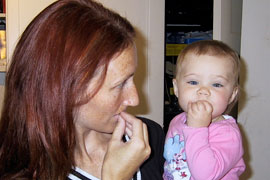Sign Language and Babies

Sign language is a great tool to help reduce temper tantrums in your baby and toddler. Studies have shown that teaching pre-verbal children how to use simple signs to communicate with you will help to reduce their frustration. This is because they are able to tell you what they want, eliminating many guessing games.
When my daughter was 10 months old, I was giving her Cheerios in her highchair and she kept throwing them on the ground and signing ‘more’. I said to her, “You don’t want ‘more’! What do you want?” and she signed ‘more’ ‘cheese’.
I was amazed that my 10 month old signed two words together, but also that she was able to easily
tell me what she wanted. Additionally, there was no cheese in sight and I hadn’t offered her any during this snack time. If she didn’t have that sign to use, then I would have assumed she was finished because she was throwing her food on the floor. She would then have been angry and frustrated, possibly resulting in a temper tantrum.
Sign language as a tool is also very handy when children are learning how to talk. Many times the child is not always clear in his speech and we can’t be100% sure what word they are saying. For example, some kids might say ‘ba’ and it means a number of things like, ball, bath, bottle, book etc. If your child is signing, you can then understand what he wants, eliminating the frustration of having to guess.
Here are five great signs to start with:
- Milk. This is a perfect sign to use with your baby whether you are nursing or bottle feeding, because you’ll be giving your child milk numerous times a day.
- More. Here’ s another important sign because it will allow you to ask if they want ‘more’ of something. An interesting point I always tell parents is that most times babies view the word ‘more’ as ‘I want’. Keep this in mind as they may not want ‘more’ of what they have but something else.
- Finished. This goes hand-in-hand with ‘more’. If you teach your child ‘finished’, you will be able to know if your child is truly done or if he might want ‘more’ of something else.
- Favourite Food Sign. This will vary from baby to baby. Pick a food that your child loves and teach him the appropriate sign. Don’t hesitate to take his hands and show him how it feels to make the sign.
- Favourite Toy or Item Sign. Pick something that your baby is really interested in. My son loves dogs, so that was one of his first signs. My daughter loves books. It helps to pick signs that babies will be motivated to learn.
Using sign language is as easy as teaching a child how to wave good-bye. The most important thing to remember is to be consistent. If you are choosing to teach the sign ‘milk’, then every time you say the word milk you should make the sign. Just like reading a book or teaching a song, this is just another enhancement you can bring to your child’s life.














